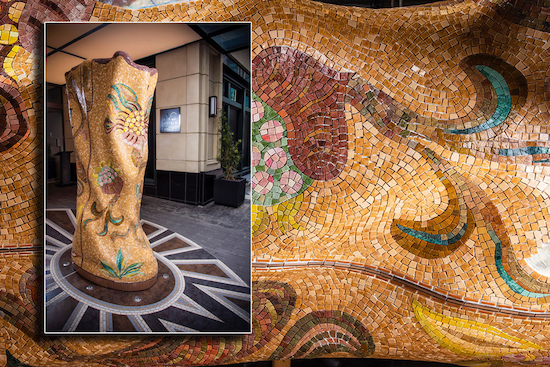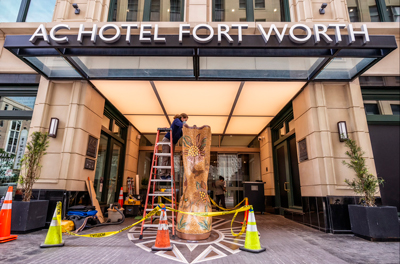

In early 2020, Texas commercial real estate developer Jackson Shaw wanted a show-stopping sculpture and surrounding mosaic flooring to greet guests as they arrived at the Antonio Catalan (AC) Marriott Hotel in Fort Worth. As one of many swanky collaborations between AC Hotels President Antonio Catalan and Marriott International, the 252-room, 16-story hotel would be the first for the city. Strategically situated in the heart of downtown’s booming Sundance Square, which has served as the new hotspot for top-tier employers and major U.S. headquarter relocations over the past few years, the hotel would emanate a classic modern design with European soul and Spanish roots, complementing the legacy Fort Worth is known for.

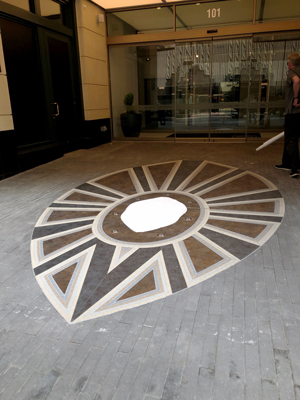
With the boot stitch mosaic flooring sitting at the exterior entry and near the valet stand, materials had to be weather-resistant and suitable for heavy pedestrian traffic, as well as pulled luggage. 
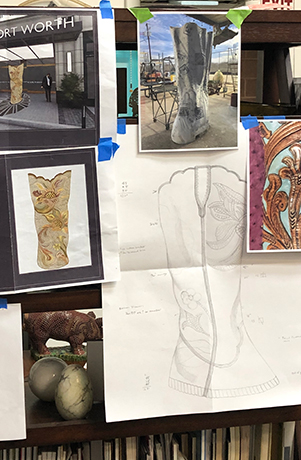
Plans for a 77.8 square-foot [7.23 square meter] Pamplona Rose Column, inspired by Spanish-rose themed leatherwork and sunburst stitch seen on custom boots, would greet guests before they check-in.
Jackson Shaw selected accomplished mosaic designer Julie Richey, owner of Julie Richey Mosaics, to spearhead what would be one’s first impression before entering the hotel: an elaborate mosaic entryway featuring a column sculpture and surrounding mosaic flooring. Jackson Shaw’s main request was that the artistic feature would exude a “contemporary design with a Western flair,” which would also complement the ambiance of the hotel’s interior. Inspired by local boot maker M.L. Leddy, located in the historic Fort Worth Stockyards, Richey planned to incorporate the company’s custom design aesthetic into 11′ x 10′ [3 by 3.4-meters] mosaic flooring situated in the exterior entry. Plans for a 77.8 sq. ft. [7.23 square meter] Pamplona Rose Column, inspired by Spanish-rose-themed leatherwork and sunburst stitch seen on custom boots, would also greet guests before they check in.
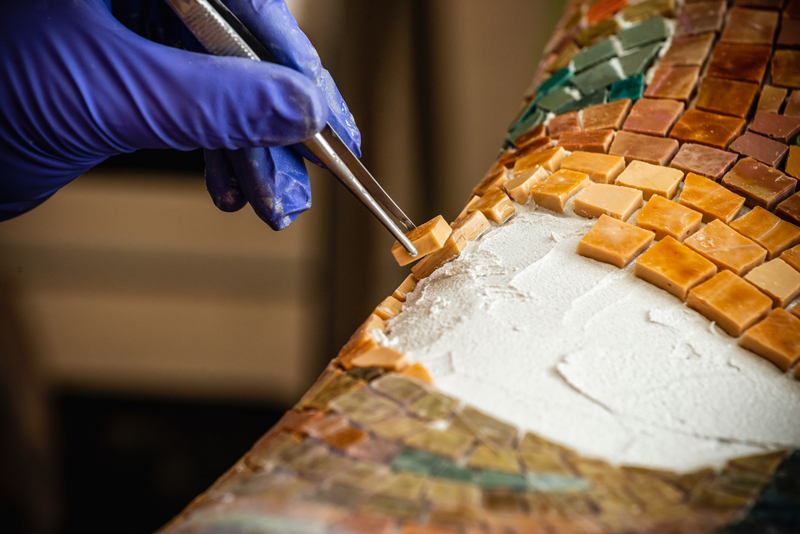

Hoping to open in fall 2020, Richey hit the ground running on the project. With more than 30 years of experience in creating custom mosaic artwork and a portfolio of notable projects that spanned the globe, Richey knew that a project of this size needed dependable, high-performance products.
“I have always had excellent results with LATICRETE and trust the quality,” she said. “Working on commercial and residential mosaic projects means each one has a different set of challenges: site, intended use, physical materials, etc. In any situation, the LATICRETE technical support services are an essential tool for me to learn which materials work best for any given application.”

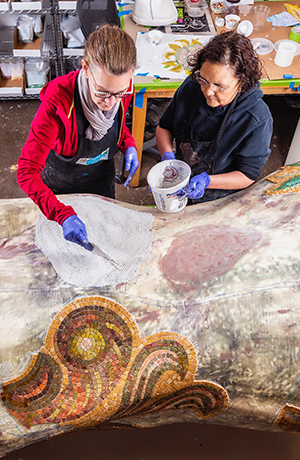
The team spent 600 hours over seven weeks applying the mosaic. Work sessions were divided into three- to four-hour blocks to account for the epoxy’s brief open time, allowing the teams to apply mosaic for about 90 minutes before the adhesive flashed. 
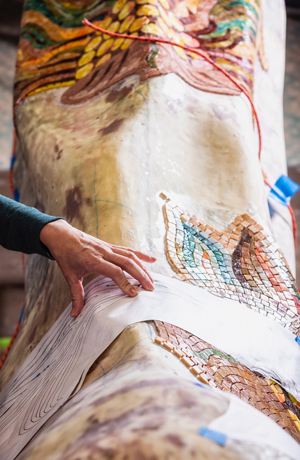
The undulating surface of the substrate meant the designs could not be fabricated in one continuous piece but in separate elements.
The project would be commissioned in two phases: the mosaic flooring – which is a boot-stitch pattern outlining solid, waterjet-cut slabs of Neolith porcelain, and the column – an 8′ tall [2.4 meters] fiberglass form clad in mosaic tiles. In total, the project would encompass more than 200 pounds [90.7 kilograms] of glass mosaics in 35 different colors.
Exterior conditions, compatibility issues and the pandemic spur challenges
Exterior conditions: With the boot-stitch mosaic flooring sitting at the exterior entry and near the valet stand, materials had to be weather-resistant and suitable for heavy pedestrian traffic, as well as pulled luggage. Since the column also had to be weatherproof, it needed to be constructed of fiberglass around a steel armature before mosaic tile could be installed.
Compatibility issues: The mosaic glass for the column was traditional smalti from Mosaicos Venecianos de México in Cuernavaca, so traditional thin-set mortar wouldn’t be compatible with a fiberglass substrate. Plus, the undulating surface of the substrate meant the designs could not be fabricated in one continuous piece, but would need to be created in separate elements.
Working amidst a pandemic: COVID-19 lockdown occurred just as Richey was chosen for the project, so most of the meetings and presentations took place virtually, with the exception of site visits to determine the scale and placement of the elements. Lockdowns further slowed construction on-site, but the hotel’s opening weekend was time-sensitive, so the installation of the mosaic flooring had to be completed by early fall.
LATICRETE technical support helps hone the perfect solution
Richey began fabricating the boot-stitch portion by using 1″ x 2″ unglazed porcelain to form the borders for the large ceramic pieces and face-taping the mosaics with clear mosaic mounting tape, which was labeled for the physical application. Once the mosaic was fully set, LATICRETE® SPECTRALOCK® PRO Premium Grout was applied. Designed for residential and commercial use on ceramic tile, glass tile and stone applications, SPECTRALOCK PRO Premium Grout offers superior non-sag performance, unmatched stain resistance and color uniformity for an even finish without any blotchiness or shading. Working with Sigma Marble of Dallas, Richey brought the sections to the hotel and assisted in the installation of the Neolith and flooring.
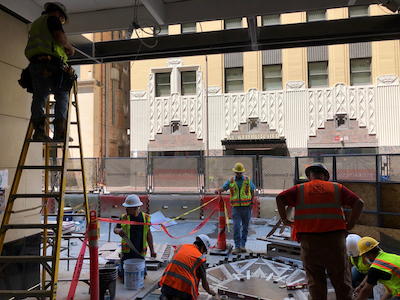

Inset light fixture receptacles surrounded where the sculpture would sit, giving Sigma installers the difficult task of templating each fixture’s location and drilling the fragile Neolith on-site to ensure a snug fit. Using the classic “lipstick trick,” the team templated the holes by rubbing bright red lipstick on the receptacles, transferring the smudges to a piece of Coroplast® and marking the holes on the Neolith.
Once the installers set the template, the fragile pieces of large-format slabs and expansion joints, the mosaic flooring was caulked with LATASIL™, a high-performance, one-component, neutral-cure, 100% silicone sealant designed for ceramic tile and stone applications.
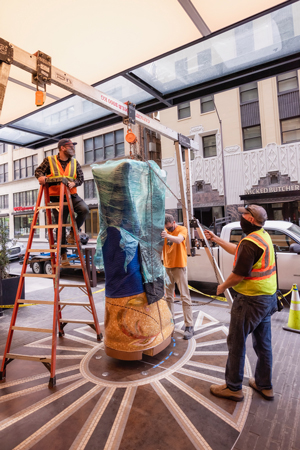

After the surrounding decorative flooring was done, Richey began prefabricating the mosaic design for the Pamplona Rose column while she waited for the physical structure to arrive. Blue Genie, the Austin-based company chosen to fabricate the interior steel armature and the fiberglass sculpture form, reconstructed Richey’s maquette into reality for the smalti-clad, 8’ tall [2.4 meters] design that would pay homage to the Spanish origins of the hotel brand.
Due to the unusual material of the sculpture base, Richey turned to the technical experts at LATICRETE prior to selecting the adhesive. Knowing that traditional cement-based adhesives aren’t compatible with fiberglass – especially outdoors – the LATICRETE representatives specified LATAPOXY® 300 Adhesive, a chemical-resistant, three-part epoxy adhesive that is easily spread and tenaciously bonds to challenging substrate types like this one. After some experimentation, and a lot of calculations to determine the correct proportions for LATAPOXY 300 Adhesive, the mosaic application began on the armature. The team spent 600 hours over seven weeks applying the mosaic. Work sessions were divided into three- to four-hour blocks to accommodate the epoxy’s brief open time, allowing the teams to apply mosaic for about 90 minutes before the adhesive flashed. Each section had to also be taped to the fiberglass to prevent sagging while they cured.
Richey chose both SPECTRALOCK® PRO Premium Grout and LATASIL again for Sigma Marble to grout and caulk the structure. Three professionals and five hours later, the piece was finished and ready for curing.
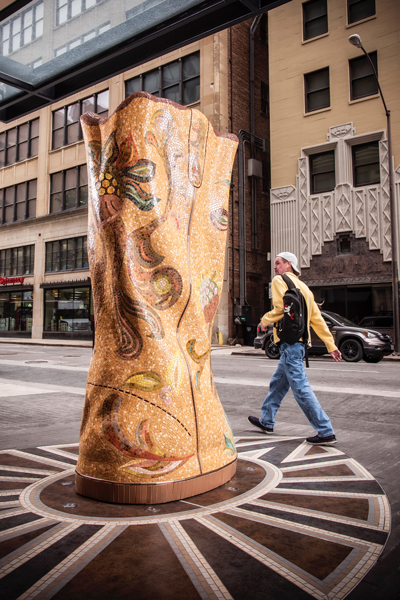

AC Hotel kicks up its heels with mosaic artistry
Once cured, the completed sculpture was carefully transferred to the hotel site where it would be situated in the center of the previously-installed surrounding mosaic flooring. Blue Genie used a rented gantry to bolt the mosaic into place. After drilling the bolts on and applying epoxy to seal them into place, the project was complete.
The chic AC Hotel blazed into the Fort Worth hotel scene in September 2020. After long anticipation and hype surrounding the unveiling of the Pamplona Rose sculpture, it officially made its debut in April 2021. Since the opening of the AC Hotel Fort Worth, it has been praised as an upscale and inventive hotel where guests are able to immerse themselves in the authenticity and culture upon which the city was built.
Photographer: Danny Fulgencio


